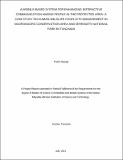A mobile-based system for enhancing interactive communication among people in the protected area: a case study on human-wildlife conflicts management in Ngorongoro conservation area and Serengeti national park in Tanzania
Abstract
One of the core human rights is the right to the best possible health for humans and a balanced
ecology for wildlife. Electric fences are the only way to prevent human-wildlife conflict, but they
are ineffective in many countries due to the high cost of power management required to operate
them. Camera trap management can help this problem, however, in underdeveloped nations like
Tanzania, it fails to owe to poor GPS usage, which prevents the information from being reported to
the protected area authority. The goal of this study is to create a mobile application A mobile-based
human-wildlife conflict Management App) that would help to solve the human and wildlife
conflicts within Tanzania’s Ngorongoro Conservation Area and Serengeti National Park. Mobile
application captures video from camera trap and allows to report the information to the park rangers
through live chatting. Interviews, observations, and questionnaires were used to gather information.
The findings suggest that 93% from interviews and observation of people thought it to be really
useful for receiving video from camera trap to the mobile app and able to report information to the
protected area authority. The remaining 7% were unable to fix the problem due to a lack of
smartphones and poor internet access within the protected area. Within the villages, the application
may be used with a smartphone and a decent internet connection. People in the protected area gave
the designed system positive feedback, with 95.2% of those who completed the system evaluation
agreeing that the App should be used. Further development of the application would necessitate
more functionality and improved internet accessibility.

